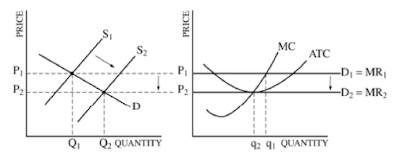ALL Perfect Competition FRQ's
2017 AP Microeconomics Exam
(A.) Draw a side-by-side graph of the corn market & firm that is perfectly competitive.
(i) Show Equilibrium price and quantity
(ii) Show the profit maximizing quantity with the firm earning zero economic profits.
 |
| The firm is producing at Profit Max (MR = MC) The firm is earning Zero Economic Profit (Break-Even) (P = ATC) All Explicit and Implicit costs are covered |
(B.) Assume the demand for ethanol increases. Show what will happen to the following.
(i) The market price and quantity for corn.
(ii) The area of profit or loss earned by the corn farmer , shaded.
If we are making Positive Economic profits in the short-run,
this attracts firm to enter the market in the Long-Run
As firm enter the Supply of corn increases and the
price of corn falls the firms quantity decreases
but the market for Corn has an increase in quantity
We return to long-run equilibrium making zero economic profits
(D.) Soybeans are produced in a perfectly competitive market. Assume farmers can grow either soybeans or corn. What happens to the price of soybeans in the next planting season if the price of corn increases? Explain.
If the Price of corn increases farmers are now making higher profits on corn,
therefore they will plant more corn and less soybeans
less supply of soybeans means higher prices for soybeans
(E.) Assume the gov't sets a binding price on the price of corn. Draw a graph of the Corn Market showing the amount purchased.
 |
| Recognize that Qp the amount purchased is based on the amount supplied doesn't matter how much is demanded,, if it ain't supplied you can't purchase it. |
2015 AP Microeconomics Exam
2011 AP Microeconomics Exam
2008 AP Microeconomics Exam
2005 AP Microeconomics Exam
2005B AP Microeconomics Exam
2003 AP Microeconomics Exam
2003B AP Microeconomics Exam





























































No comments:
Post a Comment